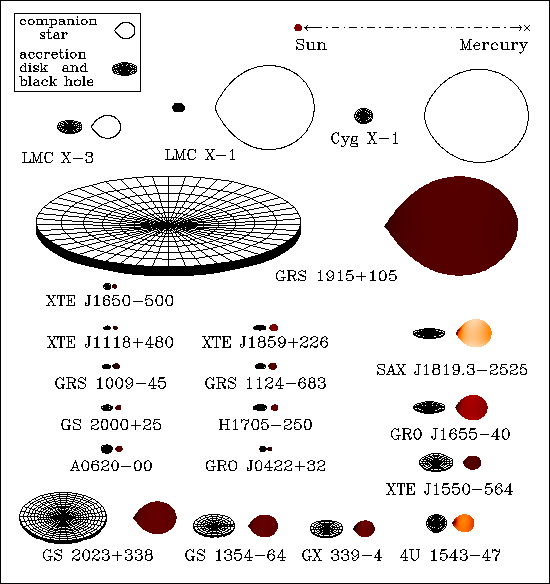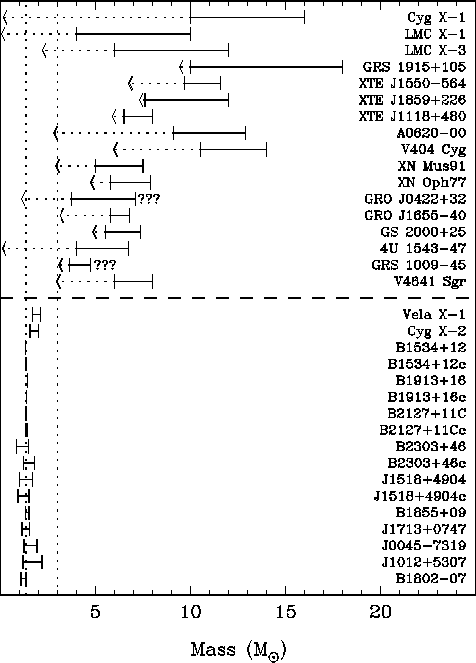Jerome Arthur Orosz
Contact Information:
Office: Physics 241
Mailing Address:
5500 Campanile Drive
PA 210
San Diego, CA 92182-1221
United States
Phone:+1-619-594-7118
Fax: +1-619-594-1413
email:
jorosz[at]mail.sdsu.edu

This is a schematic diagram of the 20 dynamically confirmed black
hole binaries. Seventeen have low mass companions (i.e. stars with masses
less than about 3 solar masses), and the three on the top have
high mass companions.
The color scale for the 17 objects with low mass companions represents the
temperature of the star (Cyg X-1, LMC X-1, and LMC X-3 all have companions
which are considerably hotter, and it is difficult to make a good color scale
that includes all objects).
Click
here for a PostScript version of this
image (it is a bit clearer when printed out on a high resolution
color printer).
Other images:
Click
here for a GIF version with
variable star names, and
(here for a PostScript version).

This is a compilation of the mass ranges for the 17 black holes
pictured above. The arrows for the black holes point to the mass function,
which is a firm lower limit for the mass of the black hole. In most cases
the mass function is quite well known. In a few cases like GRS 1915+105,
XTE J1550-564, and XTE J1859+226,
the error on the mass function is still relatively large.
Some of the limits shown are 95% confidence limits
(e.g. GRO J1655-40), some are 1 sigma (e.g. GRS 1915+105), and
some limits are educated guesses of the inclination
based on reports of the light
curve morphology and reasonable estimates for the secondary star's
mass (e.g. XTE J1859+226).
In the near future
I hope to analyze most or all of the
systems in a uniform way so that it becomes easier to compare the
observed mass distribution with theory.
Click
here for a PostScript version of this
image.
Teaching:
ASTR 101, Principles of
Astronomy: Fall 2003, Spring 2004, Summer 2004, Fall 2004, Spring 2005,
Summer 2005, Fall 2005 (2 sections), Spring 2006, Summer 2006, Fall 2006,
Spring 2007 (2 sections), Fall 2007 (2 sections), Spring 2008,
Spring 2009 (2 sections), Fall 2009 (2 sections), Spring 2010,
Fall 2010, Spring 2011 (2 sections), Fall 2011 (2 sections),
Spring 2012, Fall 2012, Spring 2013 (2 sections), Fall 2013,
Spring 2014, Fall 2014.
ASTR 450, Astrophysics
of Star Systems: Spring 2003, Spring 2005.
ASTR 510, Exoplanets: Fall 2013.
ASTR 610, Binary Stars: Fall 2002, Fall 2004, Fall 2006,
Fall 2010, Fall 2012, Fall 2014.
ASTR 620, Galactic
Structure: Spring 2004, Spring 2006, Spring 2008, Spring 2010,
Spring 2012, Spring 2014.
ASTR 101, Principles of
Astronomy: Spring 2015, section 2 (T TH 11:00-12:15).
ASTR 101, Principles of
Astronomy: Spring 2015, section 3 (T TH 14:00-15:15).
Research Interests:
X-ray binaries and black holes, light curve synthesis,
accretion disk physics, stellar photometry.
I was a graduate student in the
Yale University Department of Astronomy
where I did a thesis called "Optical Observations of Black Hole
X-ray Novae" (click here for a brief
summary).
I have recently moved here to San Diego.
Previously I was at the
Sterrenkundig Instituut
of the Universiteit Utrecht
supported by Marten van Kerkwijk and Frank Verbunt, and before
that at
the
Department of Astronomy and Astrophysics at
The Pennsylvania State University.
I was working with
Richard. A. Wade
on models of the UV spectra of selected cataclysmic
variable stars in order to better understand the spectral line formation in
the hot inner regions of the accretion disks found in these systems.
I continue to collaborate with Charles Bailyn (Yale University), Jeffrey McClintock
(Harvard-Smithsonian
Center for Astrophysics), and Ronald Remillard
(Center for Space Research
at the Massachusetts Institute of
Technology) on optical and X-ray observations of black hole binaries.
Click here for recent results on M33 X-7.
Click here for a finding chart of 4U 1700-377.
Here is a ''Clear Sky Clock'' for Mount Laguna Observatory generated
by
Attilla Danko.
Click on the image for more information.


Last updated 2010 February 28



